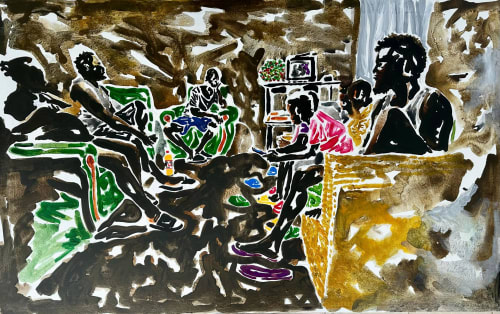In 'ètô y’a Nda-bot: Intimate Interiors' Salomon Moneyang offers a luminous and layered exploration of home, not as fixed geography, but as a shifting interior terrain shaped by memory, inheritance, and return. Informed by his journey back to his ancestral village in Cameroon, Moneyang’s paintings dwell within the quiet pulse of the domestic, asking what it means to truly enter the house; architecturally, emotionally, intergenerationally, and spiritually.
Working in both watercolour and acrylic, the artist navigates interior life through visual language – quiet observation, gesture, and negative space. His watercolours, delicate and transparent, function as fleeting memory maps: a man reclining mid-thought, a child man beside a basin, soft outlines of movement and stillness rendered in bleeds and washes. These works speak to the fragility of memory and the tenuous bonds of kinship, echoing what Gil Scott-Heron called the understanding that “a home is not a home.” In contrast, the acrylic paintings are assertive and full-bodied: densely painted, emotionally charged. Saturated reds, browns, and shadowed greens articulate rooms that are at once sheltering and energised – these spaces, whether solitary or peopled, feel emotionally complex. Conversations seem to linger in the air, glances fall heavy on surfaces, silence takes on form. Domestic objects, bottles, chairs, curtains become symbolic witnesses to histories felt but unspoken.
Salomon Moneyang’s return is not a romantic one. It is tense, critical, loving. He stages the rural-urban divide not only as a spatial split, but as an existential one; between tradition and negotiations with modernity, between inherited memory and lived experience. And crucially, as a Black male artist working with the intimate and the domestic, Moneyang reorients masculinity away from dominance and toward care, observation, and vulnerability. The domestic, often gendered as a site of women’s labour, here becomes a ground for quiet masculinity, for attentive looking, for radical tenderness.
This exhibition is influenced by the work of Wilfried Mbida, whose project Kédé Ndap similarly explores the emotional and historical density of interiors. Mbida writes, “I go to meet myself.” In ètô y’a Nda-bot: Intimate Interiors, Moneyang does the same. He meets himself through the memories, rooms, and family textures that shaped him.
This is not simply a show about returning home. It is about reentering one’s own story, and discovering how deeply the rooms we inhabit inhabit us.

